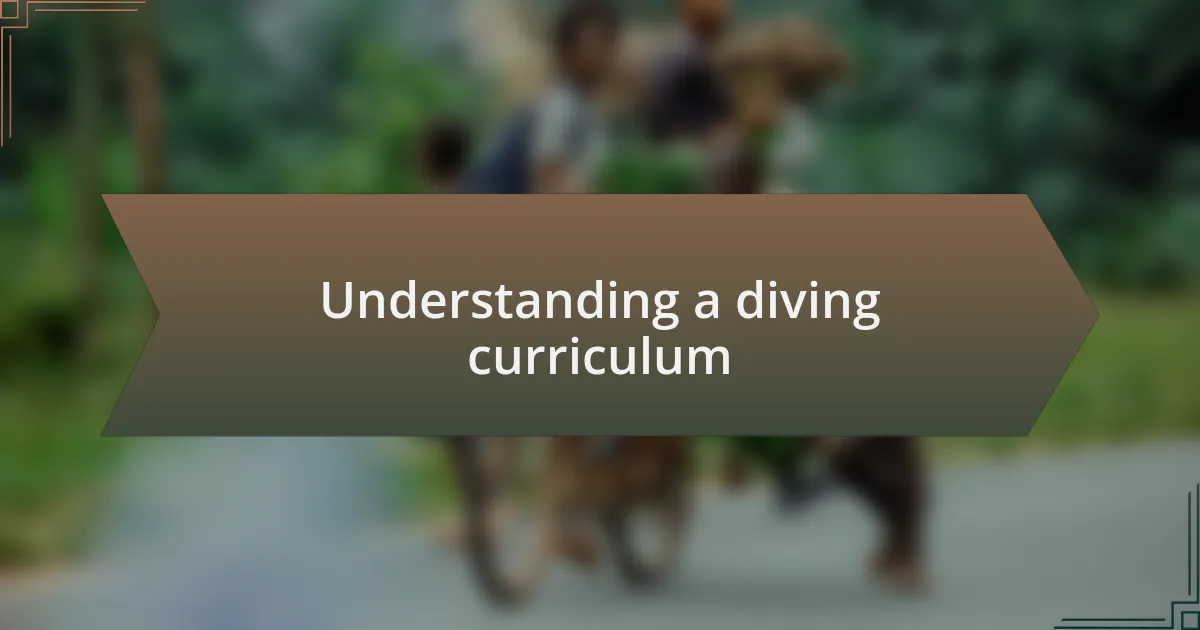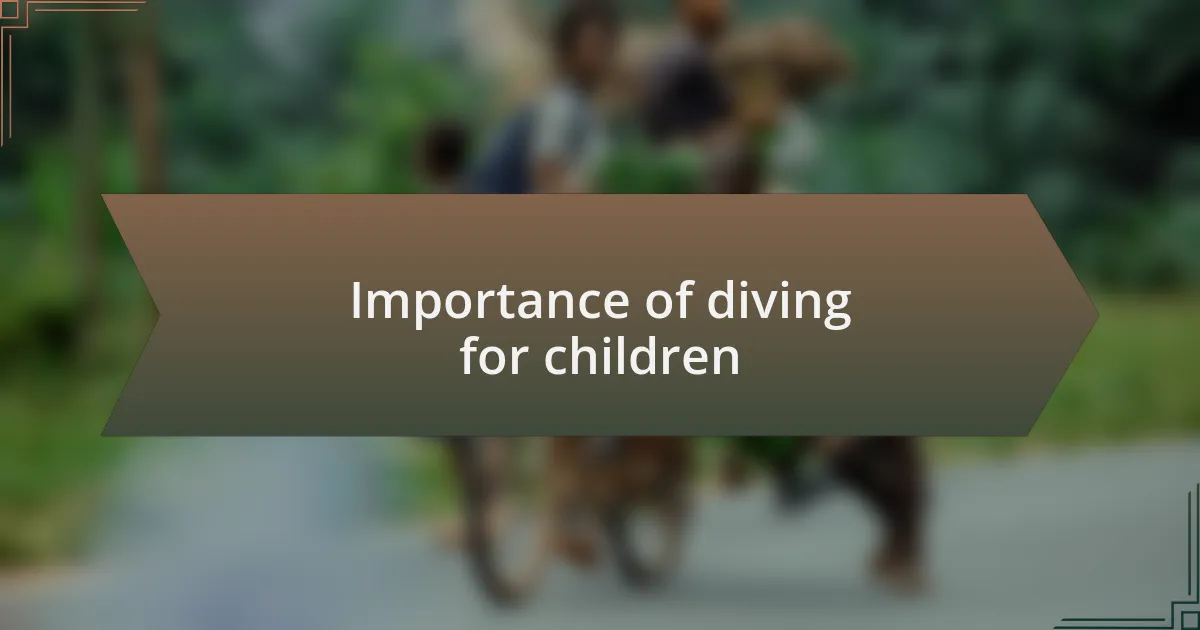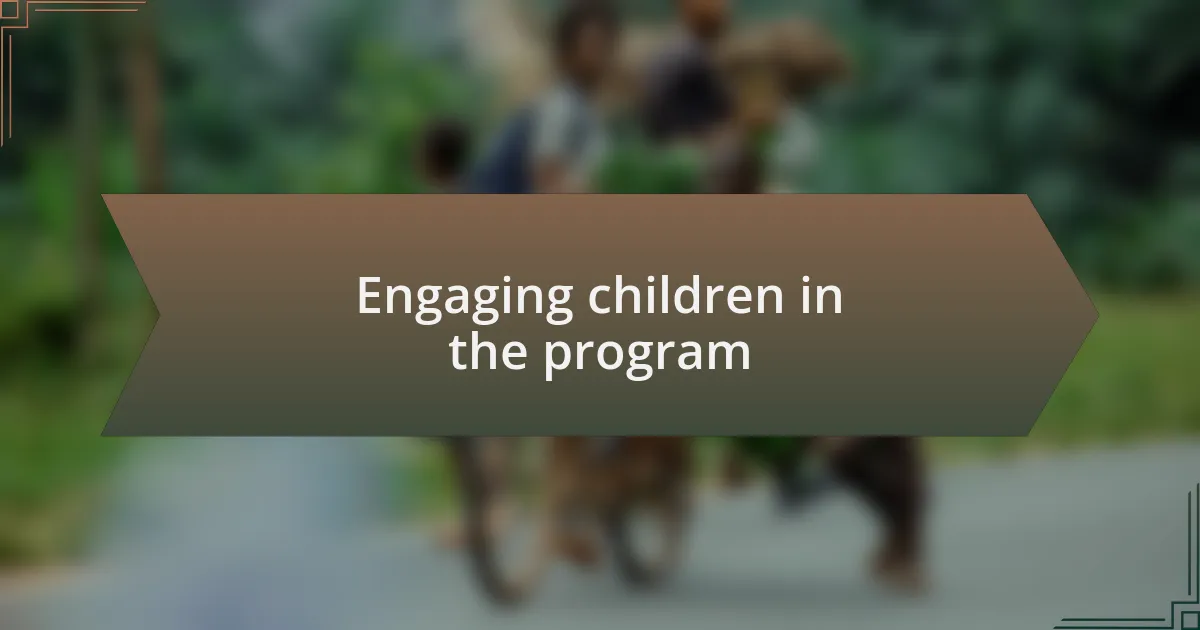Key takeaways:
- A diving curriculum should blend technical training with environmental education to foster respect for marine life and responsibility among young divers.
- Engaging and fun learning experiences, such as games and storytelling, enhance children’s enthusiasm and confidence in diving.
- Safety measures, including the buddy system and regular drills, are crucial for building confidence, trust, and teamwork among young divers.
- Flexibility and adaptability in teaching approaches, along with incorporating feedback from parents, significantly enhance the effectiveness of the curriculum.

Understanding a diving curriculum
A diving curriculum is more than just a set of lessons; it’s a structured path to building confidence and safety underwater. I remember when I first introduced children to diving, their wide-eyed wonder was an experience unlike any other. This curriculum aims to nurture that curiosity while instilling essential skills and a deep respect for marine life.
At its core, a diving curriculum should include not just technical training but also an understanding of the marine environment. I often find myself asking, how can we expect young divers to love and protect our oceans if they don’t first understand them? Incorporating environmental education alongside diving skills creates a holistic approach that fosters a sense of responsibility in the next generation of divers.
Finally, flexibility is key in any diving curriculum. Each child learns at their own pace, and I can recall moments where we had to adapt lessons on the spot because a child was nervous or excited about a particular skill. This responsiveness is crucial; it reinforces the idea that diving isn’t just about technique—it’s about personal growth and having fun in the water.

Importance of diving for children
Diving holds immense importance for children as it opens a gateway to discovery and adventure. I remember the first time my students experienced that exhilarating moment when they took their first breath underwater. Their faces lit up with pure joy, showcasing how diving not only introduces them to a new world but also builds a strong sense of self-accomplishment.
The physical benefits of diving cannot be overstated either. It strengthens muscles, improves coordination, and enhances overall fitness. I often think about how these skills translate into other areas of their lives—whether it’s playing sports or simply having the confidence to try new things. Isn’t it amazing how a single dive can empower children in so many aspects?
Moreover, diving cultivates a deep connection with nature. Each time we explore a coral reef, I see a shift in the children’s appreciation for the environment. They start to ask questions about marine life and conservation, showing that diving sparks curiosity and responsibility toward protecting our oceans. How powerful is it to witness young minds evolving in such meaningful ways?

Elements of a successful curriculum
When crafting a successful diving curriculum, clarity and structure are vital elements. Each lesson should build upon the previous one, creating a logical progression that reinforces learning. For instance, I recall how I designed a module focusing on underwater signals. It became a pivotal moment when my students learned to communicate below the surface. Their excitement was palpable as they practiced these essential skills, highlighting the importance of structured learning in diving.
Engagement is another critical factor. It’s not enough to just impart knowledge; the curriculum must inspire curiosity and enthusiasm. I’ve seen firsthand how incorporating games and challenges made my classes interactive and fun. One day, I introduced a treasure hunt during a dive, and suddenly, the students were not just learning; they were fully immersed in the experience. Isn’t it incredible how play can deepen understanding?
Lastly, safety is paramount in any diving curriculum. I always emphasize the significance of safety protocols, not just as rules but as an essential mindset. During one lesson, we practiced emergency procedures, and it was heartening to see the students take it seriously. Their faces reflected a mix of concentration and determination, reinforcing my belief that a strong emphasis on safety helps children build confidence and become responsible divers. How reassuring is it to know they leave with both skills and a safety-first attitude?

Incorporating safety measures in diving
In my experience, teaching diving safety measures starts long before students hit the water. During the very first session, I introduce them to the concept of the buddy system, which is essential in enhancing safety. I recall a time when a child expressed concern about diving alone. We turned that anxiety into excitement, emphasizing how buddies can look out for each other, fostering trust and collaboration from the outset. Isn’t it comforting to think that partnerships can make adventures safer?
Another vital aspect of safety is familiarization with equipment. I always make it a point to let my students handle their gear before even stepping into the pool. I remember a nervous child who, after struggling with the weight of the tank, soon found joy in adjusting their mask and fins. The transformation was remarkable—seeing that same child realize they could master their equipment sparked a newfound confidence that went beyond just diving. How empowering it is for kids to feel in control, ensuring they are both safe and prepared?
Finally, regular safety drills are non-negotiable in my curriculum. They help reinforce proper response to emergencies in a controlled environment. I once conducted a mock scenario where we simulated a diver needing assistance. The look of seriousness in my students’ eyes as they worked together to resolve the situation was profoundly moving. It struck me then how these drills not only prepare them for real-life situations but also cultivate resilience and teamwork. Isn’t it amazing how practicing for the unexpected can foster strong bonds among young divers?

Engaging children in the program
When I think about engaging children in the diving program, I realize the importance of making learning fun. One afternoon, I decided to host a mini treasure hunt in the shallow end of the pool. The kids eagerly searched for colorful objects I had scattered around, transforming the lesson into an adventure. Their laughter and excitement were contagious, proving that when they see learning as play, their enthusiasm skyrockets.
I’ve also found that storytelling plays a crucial role in capturing their attention. During one session, I narrated a tale of a brave little diver who explored the ocean depths and made friends with a curious dolphin. The spark in their eyes as they listened and imagined themselves in the story was a powerful reminder of how creativity can enhance their experience. Shouldn’t every lesson inspire a sense of wonder?
Additionally, I encourage hands-on activities, allowing children to experiment with various diving skills. I once let them practice snorkeling techniques while blowing bubbles—they giggled at the funny shapes the bubbles made! This lighthearted approach not only builds their confidence but also fosters a sense of belonging among peers. How exciting is it to watch them bond over shared experiences while learning vital diving skills?

Personal reflections on curriculum development
Reflecting on my experience in curriculum development, I realize the profound impact of adaptability. I remember a time when I had to pivot my lesson plan to accommodate a child who was hesitant to participate. By introducing adaptive equipment and breaking down the skills into smaller, manageable parts, I saw that child’s confidence blossom. Isn’t it fascinating how a slight change can unlock a world of possibility?
Another aspect I’ve come to appreciate is the significance of feedback. After each lesson, I invite parents to share their observations. One parent mentioned how her child now dreams of becoming a marine biologist, and that insight filled me with joy. It reminds me that our curriculum not only teaches skills but ignites passions and dreams. How could I possibly create a learning experience without considering the voices of those we serve?
Lastly, I find that collaboration enriches the curriculum. Working alongside fellow instructors, we exchanged ideas and resources, and it became evident that diversity in teaching methods can enhance learning outcomes. I recall a brainstorming session where an instructor suggested integrating environmental education into our diving lessons. What a revelation—connecting children’s love for diving with care for ocean conservation added a layer of responsibility to our program that I hadn’t considered before!